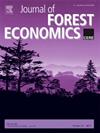Timber Price Dynamics After a Natural Disaster: A Reappraisal
IF 0.7
4区 农林科学
Q3 ECONOMICS
引用次数: 2
Abstract
Natural disasters such as a hurricane can result in massive timber loss in a forested region. Timber prices in the affected region can drop sharply at the beginning and then recover gradually. In this study, the determinants of timber price recovery and the magnitudes of their contributions are analyzed through a partial equilibrium displacement model. Hurricane Hugo of 1989 is used to calibrate the model for pine sawtimber and pulpwood markets separately in South Carolina, USA. The amount of timber inventory loss and intensity of salvage harvests are found to be the leading determinants behind timber price recovery, and they can explain the recovery thoroughly if the uncertainty of model inputs is also considered simultaneously. The impact of curve rotation (i.e., the change in demand or supply elasticity across the quarters) is small and hardly separable from that of model input uncertainty. A potential trade between the damaged and surrounding regions after the hurricane can be used to explain some of the price recoveries, but the amount of trade is likely to be small, especially for pulpwood.自然灾害后木材价格动态的再评价
飓风等自然灾害会导致森林地区大量的木材损失。受灾地区的木材价格可能在开始时急剧下降,然后逐渐回升。在本研究中,通过部分平衡位移模型分析了木材价格恢复的决定因素及其贡献的大小。1989年的雨果飓风分别用于校准美国南卡罗来纳州松材和纸浆市场的模型。发现木材库存损失量和回收采伐强度是木材价格回升的主要决定因素,如果同时考虑模型输入的不确定性,它们可以彻底解释木材价格的回升。曲线旋转的影响(即需求或供给弹性在各个季度的变化)很小,很难与模型输入的不确定性分开。飓风过后,受灾地区和周边地区之间的潜在贸易可以用来解释一些价格回升的原因,但贸易量可能很小,尤其是纸浆木材。
本文章由计算机程序翻译,如有差异,请以英文原文为准。
求助全文
约1分钟内获得全文
求助全文
来源期刊

Journal of Forest Economics
农林科学-林学
CiteScore
1.70
自引率
0.00%
发文量
16
审稿时长
>36 weeks
期刊介绍:
The journal covers all aspects of forest economics, and publishes scientific papers in subject areas such as the following:
forest management problems: economics of silviculture, forest regulation and operational activities, managerial economics;
forest industry analysis: economics of processing, industrial organization problems, demand and supply analysis, technological change, international trade of forest products;
multiple use of forests: valuation of non-market priced goods and services, cost-benefit analysis of environment and timber production, external effects of forestry and forest industry;
forest policy analysis: market and intervention failures, regulation of forest management, ownership, taxation;
land use and economic development: deforestation and land use problem, national resource accounting, contribution to national and regional income and employment.
forestry and climate change: using forestry to mitigate climate change, economic analysis of bioenergy, adaption of forestry to climate change.
 求助内容:
求助内容: 应助结果提醒方式:
应助结果提醒方式:


